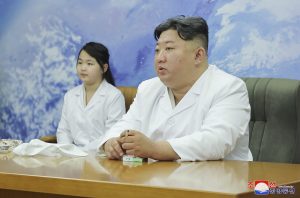South Korean President Yoon Suk-yeol’s foreign policy is not something you would normally expect to see from a politician. Conservative governments in South Korea have traditionally taken a hardline stance on North Korea and focused on the alliance with the United States. Yoon, however, is also reaching out to Japan, relations with which have been troubled by historical and territorial issues, following his own convictions and with little concern for domestic public opinion. Yoon’s unconventional approach may well be explained by the former prosecutor general’s lack of political experience before running for president.
Partly because of Yoon’s initiative, several summit meetings between South Korea and the United States as well as Japan have been held in quick succession, and cooperation among the three countries on the North Korean issue is rapidly deepening. North Korean opposition has been striking, with Kim Yo Jong, deputy director of the Publicity and Information Department at the Workers’ Party of Korea (WPK) and top leader Kim Jong Un’s younger sister, asserting late in April that the “Washington Declaration” by the leaders of the United States and South Korea is “a typical product of extreme anti-DPRK hostile policy reflecting the most hostile and aggressive will of action.” (DPRK is an abbreviation of the formal name of North Korea, the Democratic People’s Republic of Korea.) Kim Yo Jong also warned that “the stronger the exercise of our right to self-defense will become in direct proportion to [nuclear assets deployed near the Korean Peninsula].”
Still, the many accusations that Pyongyang has leveled against the United States and South Korea have been rather restrained, employing a strong tone but using only abstract expressions. Along with this hardline stance, North Korean media has been notably focused on agricultural issues, and it is clear that it wants to avoid an unnecessary escalation as it seeks to alleviate food shortages by mobilizing soldiers for “rice planting battles.”
Kim Yo Jong has been vehemently lambasting the United States and South Korea with “statements” issued every month since last year, but it is noteworthy that at the beginning of April a new format called a “position statement” was used for the first time. These were first announced by Ri Pyong Chol, vice chairman of the Central Military Commission of the WPK, on April 17, but the appearance of this new means of communication with the outside world seems to have coincided with the diminishing presence of Kim Yo Jong. “Position statements” by an individual feel a notch lower than the conventional “statements.”
Unlike in 2020, when the North-South Joint Liaison Office was bombed as announced, Kim Yo Jong’s recent statements have only been reported by the Korean Central News Agency, with little mention in the Rodong Sinmun, which is what the general public in North Korea would read. While it is not possible to establish a causal relationship, it is worth considering that the appearances of Kim Jong Un’s daughter since last fall seem to coincide with the fading prominence of Kim Yo Jong.
Kim’s daughter was referred to as his “beloved daughter” when she suddenly accompanied the leader as he observed an ICBM launch last November. Since then, she has been described as “noble daughter” and “respected daughter” at the military parade in February this year. The use of the honorific “respected” is unusual for a girl of around 10, and it has never been used about Kim Yo Jong. Meanwhile, it was reported that the youngster not only accompanied her father but also held a stopwatch during the ICBM launch, suggesting that she is already engaged in “revolutionary activities.”
Although it is hardly time to anoint Kim’s daughter as his successor, North Koreans have no idea how many children Kim Jong Un has, so they are forced to focus only on the “daughter” that has repeatedly featured in official media reports. Perhaps related to her frequent appearances on Korean Central Television, her mother Ri Sol Ju and her aunt Kim Yo Jong have begun to be featured less prominently.
North Korean media’s coverage of Kim’s daughter is also changing noticeably. At the groundbreaking ceremony for a new street in the Seopo district of Pyongyang held on February 25, it was widely reported that father and daughter broke the ground together. This signified that the “daughter” had entered the economic sphere as well as the military sphere, but for some reason Rodong Sinmun stopped making direct mention of her immediately after that.
Nonetheless, a careful look at the footage and images released by the North Korean media shows that Kim’s daughter still appears frequently at important events. She appeared in a photo with her father, which was featured prominently when Kim Jong Un instructed the National Aerospace Development Administration (NADA) on April 18, very closely resembling the composition of a photograph taken of Kim with his own father, Kim Jong Il, right around the time he emerged as the latter’s successor. In fact, the presence of Kim’s daughter is only growing. It is likely that the regime is undergoing a process of trial-and-error as to how to best highlight her.
On February 26, the slogan “Long live Great Comrade Kim Jong Un, symbol of the might of socialist Korea and the banner of 100 victories in 100 battles!” appeared for the first time in the Rodong Sinmun. An analysis of the daily slogans next to the newspaper’s title reveals that Kim was originally referred to as the “Supreme Leader,” but that this changed to “head” in February 2021. And now it has changed again, to “symbol.” Rather than boasting immense power, the Kim Jong Un family seems to be trying to portray itself as a symbolic presence centered on authority, like the Japanese imperial family or European royal families. Kim Yo Jong, however, seems fated to play only a supporting role.

































